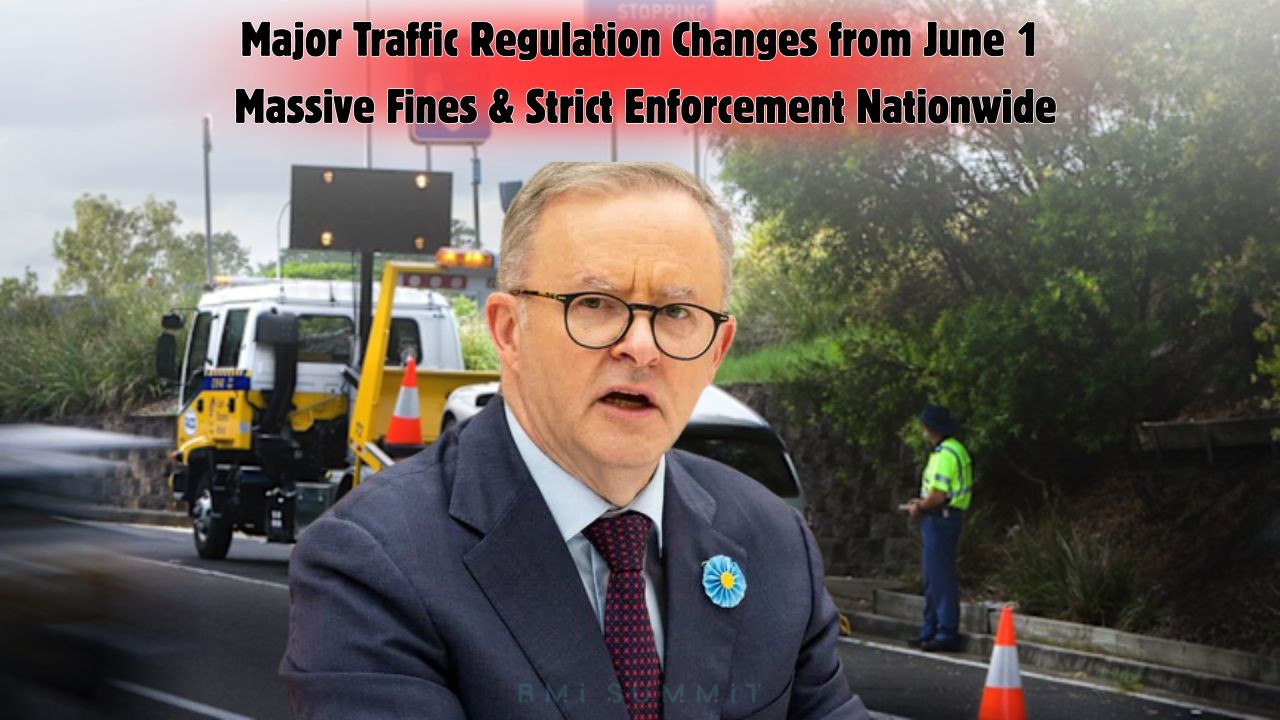Government Confirms New Traffic Regulations Effective From August 1 : Starting August 1, Australian motorists will face a stricter regime on the roads, as the government rolls out a new set of nationwide traffic regulations. These rules introduce tougher penalties, a zero-tolerance policy on key offenses, and unified standards for enforcement across all states and territories. Designed to curb reckless driving, improve road safety, and reduce fatalities, the new laws signal a major shift in how traffic offenses are handled in Australia.
With the rise in traffic-related incidents and increased public pressure for safer roads, these regulations are both timely and necessary. Here’s everything you need to know about what’s changing, how it will affect drivers, and the penalties for breaking the rules.
Why the New Traffic Regulations Are Being Introduced
The primary aim of the new traffic laws is to reduce the rising number of road accidents, injuries, and fatalities. Data from the past five years has shown a steady increase in reckless driving behaviors, especially involving speeding, mobile phone use, and driving under the influence.
Key reasons behind the reforms:
- Rising road accident statistics, especially in urban and regional areas.
- Public demand for stricter enforcement and consistent rules across states.
- Technological advancements enabling better monitoring and detection.
- Target to reduce road fatalities by 30% by 2030 as part of the National Road Safety Strategy.
These changes mark a unified national effort to promote responsible driving and introduce accountability at all levels.
Major Traffic Rule Changes Effective From August 1
From harsher fines to new enforcement methods, several changes are being implemented simultaneously across the country. These rules are expected to have a direct impact on driver behavior and law enforcement efficiency.
The most significant changes include:
- Zero-tolerance policy on drink driving and drug driving – No legal margin for blood alcohol levels in probationary or learner drivers.
- Harsher penalties for mobile phone use while driving, including increased fines and immediate license suspension for repeat offenders.
- Nationwide mandatory use of seat belts, including stricter checks for passengers.
- Increased speed camera usage, including unmarked and AI-assisted cameras.
- Unified demerit point system across all states and territories.
- Higher fines for speeding, especially in school zones and construction areas.
- Immediate vehicle impoundment for repeat dangerous driving offenses.
Traffic Fine and Penalty Comparison Table
| Offense | Previous Fine (Avg) | New Fine (Avg) | Demerit Points | Additional Penalty |
|---|---|---|---|---|
| Using phone while driving | $500 | $1,000 | 5 | Immediate license suspension (2nd offense) |
| Speeding (10–20 km/h over limit) | $250 | $400 | 3 | N/A |
| Speeding (20–30 km/h over limit) | $400 | $700 | 5 | Possible court appearance |
| Drink driving (P-plates) | $550 | $1,100 | 6 | License cancellation for 3 months |
| No seat belt | $350 | $600 | 4 | Court appearance if repeated offense |
| Driving without license | $800 | $1,200 | N/A | Vehicle impoundment possible |
| Dangerous driving | $1,200 | $2,000 | 6 | Immediate court summons |
Zero-Tolerance Policy: What It Really Means
Under the new rules, zero tolerance means no second chances for key high-risk offenses. This includes driving under the influence, texting while driving, and unrestrained passengers.
Offenses now classified under zero-tolerance:
- Mobile phone use (texting, calling, using apps while driving).
- Driving under the influence of alcohol or drugs (especially for L and P plate drivers).
- Refusing breath or drug tests.
- Not wearing seat belts or allowing unrestrained passengers.
- Aggressive driving (road rage, tailgating).
This policy is a response to numerous incidents where leniency allowed repeat offenders back on the road, often leading to tragic outcomes.
Technology and Enforcement: Smarter Roads, Stricter Oversight
To effectively implement the new regulations, law enforcement agencies will be equipped with advanced technologies aimed at identifying offenses faster and with greater accuracy.
Tech tools being deployed include:
- AI-powered mobile phone detection cameras capable of spotting phone use through windshields.
- Unmarked speed detection vehicles with 360-degree radar technology.
- Automated license plate recognition (ALPR) to identify disqualified drivers.
- Body cams for police officers to ensure transparency during traffic stops.
- Real-time database access for immediate verification of licenses and registrations.
Regional vs. Urban Impact: What Motorists Can Expect
While the rules are national, the impact will vary depending on where you drive. Regional drivers may see more mobile patrols and surprise checkpoints, while urban areas will see increased camera-based enforcement.
Regional focus areas:
- Drink and drug driving.
- Speeding on highways and backroads.
- Seat belt compliance.
Urban focus areas:
- Phone use while driving.
- Speeding in school zones.
- Red light violations.
Table: State-Wise Breakdown of New Enforcement Tools
| State/Territory | New Speed Cameras | AI Phone Detection | Patrol Increase | Demerit Integration |
|---|---|---|---|---|
| NSW | 200+ | Yes | Moderate | Yes |
| VIC | 180+ | Yes | High | Yes |
| QLD | 150+ | Yes | High | Yes |
| WA | 120+ | No (Phase 2) | Moderate | Yes |
| SA | 100+ | Yes | Moderate | Yes |
| TAS | 60+ | No (Phase 3) | Low | Yes |
| ACT | 30+ | Yes | High | Yes |
| NT | 20+ | No (Phase 3) | Moderate | Yes |
How to Stay Safe and Compliant on the Roads
Drivers are advised to take proactive steps to understand and comply with the new traffic laws. Ignorance of the law is no excuse under the new system.
What you should do:
- Avoid any mobile phone use while driving. Use hands-free systems if absolutely necessary.
- Never drive after consuming alcohol or drugs, even if under the legal limit.
- Always wear seat belts, and ensure passengers do the same.
- Regularly check your license status, registration, and demerit points.
- Stay updated through local transport websites and news channels.
FAQs for Government Confirms New Traffic Regulations
Q1. When do the new traffic rules come into effect?
The new traffic regulations are effective from August 1 across all Australian states and territories.
Q2. What is the zero-tolerance policy?
Zero tolerance means immediate penalties with no leeway for offenses like drink driving, mobile phone use, and not wearing seat belts.
Q3. Are mobile phone fines really increasing?
Yes, fines for mobile phone use while driving are doubling, and repeat offenses may lead to license suspension.
Q4. What happens if I’m caught speeding under the new laws?
Depending on the speed and location, fines have increased significantly, and you could face demerit points, court appearances, or even vehicle impoundment.
Q5. Will these rules apply uniformly across all states?
Yes, the rules are part of a national initiative, although some technologies may be introduced in phases depending on the state.
Q6. Are there changes for provisional and learner drivers?
Yes, L and P plate drivers are especially affected, facing stricter alcohol and phone usage rules.
Q7. Can I be penalized for a passenger not wearing a seat belt?
Yes, the driver is responsible for ensuring all passengers are properly restrained.
Q8. Where can I find more details on these new regulations?
Visit your local state transport department website or the official Australian Government road safety portal for detailed guides.
Australia’s new traffic regulations, taking effect from August 1, represent a bold step toward safer roads and a culture of accountability. With nationwide enforcement, stiffer penalties, and advanced detection technologies, the government is sending a clear message: dangerous driving will no longer be tolerated.
Whether you’re a new driver or a seasoned motorist, adapting to these changes is essential. Stay informed, drive responsibly, and help make Australia’s roads safer for everyone.











